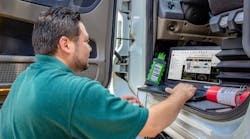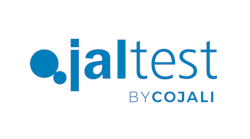The increased coverage and functionality of aftermarket heavy duty diagnostic tools has evolved significantly over the last few years. Many aftermarket heavy duty scan tools today can not only provide OEM-level information, but technicians are now able to manage bidirectional controls. Bruno Gattamorta, vice president of diagnostic sales for Cojali USA, discusses the expanded use and functionality of this tool category.
Transcription of interview:
Erica Schueller, Fleet Maintenance: Welcome to VSP News: Uptime Update. I am your host Erica Schueller, editorial director for Fleet Maintenance magazine, covering all maintenance, all vehicle classes, all management, all the time.
The increased coverage and functionality of aftermarket heavy duty diagnostic tools has evolved significantly over the last few years. Many aftermarket heavy duty scan tools today can not only provide OEM-level information, but technicians are now able to manage bidirectional controls, says Bruno Gattamorta, vice president of diagnostic sales, for Cojali USA.
We recently talked with Gattamorta about the expanded use and functionality of this tool category. He first shared more details on the history of heavy duty vehicle diagnostics.
Bruno Gattamorta, Cojali USA: In the late 1990s, electronics came onto the heavy duty commercial vehicle industry. At the beginning, there were very limited functions [for these electronic systems]. RP 1210 came out, then J1708 which evolved into J1939.
Early on, there was access to very limited diagnostic solutions. Either you were the dealer, or you had no access to it. As time evolved, OEM integrators came in, where you could buy the different OEM solution and integrate them into one platform.
Nowadays, there are multiple diagnostic platforms targeting a tendency to go into an integrated aftermarket solution. That means you can have all the truck and system manufacturers in one option - one interface, and one platform.
Schueller, Fleet Maintenance: Nearly a decade ago, the state of Massachusetts passed a law requiring vehicle manufacturers to provide independent repair shops access to diagnostic information to allow consumers the ability to choose where they would like their vehicle serviced. This law expanded into a subsequent national Memorandum of Understanding, or MOU, on the Right to Repair. While light duty and heavy duty vehicle manufacturers are outlined in separate MOUs, much of the agreement is the same.
Gattamorta shares more on how the MOU has impacted the development of aftermarket scan tools.
Gattamorta, Cojali USA: The evolution of diagnostic tools starts off with the OEM. They are the ones that build the software, they build the equipment – the engine, the transmission. That’s your go-to.
Being sold into the aftermarket has not been that easy. In the aftermarket, it’s been evolving from limited functions to giving shops more and more access as time came along.
The MOU made it mandatory for the OEMs to sell and provide that diagnostic information to everybody that wanted to buy it – anybody that wanted to repair a truck.
For a company like Cojali, that allowed us to get information and any aftermarket tool can now be developed without depending on the OEM. In essence, it liberates the aftermarket and allows independent shops to do their job without going to the dealer.
Schueller, Fleet Maintenance: What kind of dealer-level features and coverage can all-makes, all-models scan tools offer? Gattamorta discusses the next evolution of diagnostic tool functionality.
Gattamorta, Cojali USA: When we’re talking about aftermarket tools, there’s a clear evolution. At the beginning, all we could really do is read the CAN bus and get generic information. Nowadays we can have proprietary data, we can program certain parameters like speed tests and (DPF) regenerations.
Nowadays, subscription-based software is the way to go just because of the cost of development. We’ve gone from generic code reading to bidirectional controls, reading everything on a proprietary level, being able to run parameters, speed calibrations.
In the next generation, we’re seeing things that we’ve managed to do ourselves like copying ECMs and then copying them again to a new ECM that’s blank. That’s the highest level [of diagnostics] you can see in the aftermarket, and that’s going to take us to a full-on functionality in diagnostic tools.
Schueller, Fleet Maintenance: Gattamorta talks more about what trends we might expect in the future, as it relates to aftermarket heavy duty diagnostics.
Gattamorta, Cojali USA: Overall, we’re going to tend to move to remote diagnostics functionalities. Right now, there are features that are trying to get into that spectrum; with telematics you can read the ECMs, you can calibrate, and in the near future, you’ll be able to do those resets of the ECMs.
But there is also going to be apart where the education and support is going to be necessary.
Let’s say the truck is giving you that information, but if you don’t have the qualified technician to give you that support and help you with the repair, we’re not really going to get anywhere.
Schueller, Fleet Maintenance: Interested in learning more about the standard data and how it relates to the evolution of aftermarket diagnostic scan tools? Then check out the link below.
Thank you for tuning in to VSP News Uptime Update, I’m your host Erica Schueller.
Until our next broadcast, keep up with this, and other industry topics, by visiting us online at VehicleServicePros.com.

